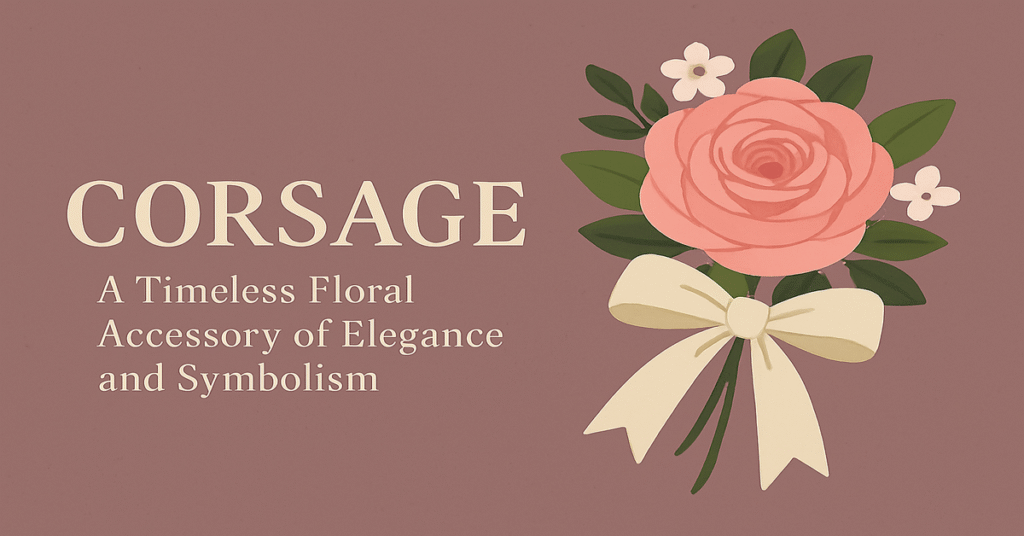A corsage is more than just a decorative floral arrangement. It is a symbol of love, celebration, and tradition that has evolved across centuries. Whether pinned to a dress or worn around the wrist, the corsage holds a special place in weddings, proms, homecomings, and formal events worldwide. Combining art, nature, and cultural significance, the corsage continues to adapt to contemporary fashion while preserving its historical roots.
In this comprehensive article, we will explore the history, types, meanings, design considerations, and modern trends surrounding corsages, shedding light on why this small bouquet holds such enduring appeal.
The History and Origins of Corsages
Ancient Beginnings
The practice of wearing flowers dates back to ancient Greece and Rome, where people wore small bundles of herbs and flowers to ward off evil spirits and bring good luck. Known as tussie-mussies in Victorian England, these small bouquets evolved into tokens of affection and status.
The Victorian Era
In the 19th century, corsages became an essential part of formal attire. Suitors would present corsages to their dates as a sign of respect and admiration. The placement and choice of flowers often held hidden meanings, part of the Victorian language of flowers.
Modern Evolution
Today, corsages are cherished accessories at proms, weddings, homecomings, and other formal events. They are symbols of honor and celebration rather than protective talismans.
The Symbolism of Corsages
Flowers as Messengers
Different flowers carry distinct meanings:
- Roses: Love and passion.
- Carnations: Admiration and good luck.
- Orchids: Luxury and strength.
- Baby’s Breath: Innocence and purity.
Color Significance
Colors also convey emotions:
- Red: Passion.
- White: Purity.
- Pink: Joy.
- Yellow: Friendship.
Corsages in Ceremonial Roles
Corsages are often worn by:
- Bridesmaids and mothers of the bride/groom at weddings.
- Graduates and honorees at academic ceremonies.
- Dates and attendees at formal dances.
Types of Corsages
Pin-On Corsages
Traditional Style
Pin-on corsages are the classic choice for formal events. They are pinned to the dress or lapel and typically feature a central flower surrounded by smaller blooms and greenery.
Wrist Corsages
Modern Favorite
Wrist corsages have become the go-to for dances and proms. They are mounted on elastic or decorative bracelets, allowing easy wear without damaging delicate fabrics.
Finger and Ring Corsages
Delicate and Trendy
Miniature arrangements attached to rings or finger bands, popular for weddings and fashion-forward events.
Shoulder Corsages
Elegant Statements
Larger corsages designed to drape elegantly over the shoulder, often seen in high-fashion contexts or as a bridal alternative.
Materials and Components
Fresh Flowers
Roses, orchids, lilies, carnations, and baby’s breath remain popular choices for their beauty and longevity.
Silk and Artificial Flowers
High-quality silk flowers offer durability and allergy-friendly alternatives. Modern artificial flowers can mimic real blooms with stunning realism.
Greenery and Fillers
Ferns, ivy, eucalyptus, and berries add texture and depth to corsage designs.
Accessories
Ribbons
Satin, organza, and lace ribbons enhance the corsage’s aesthetic and complement the wearer’s outfit.
Pearls and Crystals
Jewels add sparkle and a touch of glamour, particularly in wrist corsages.
Keepsake Bracelets
Wrist corsages often feature decorative bracelets that can be worn long after the flowers fade.
Design Considerations
Coordination with Attire
The corsage should harmonize with the color, style, and formality of the wearer’s outfit.
Floral Longevity
Choosing flowers that will stay fresh throughout the event is crucial. Florists often treat flowers to enhance durability.
Comfort and Practicality
Corsages should be lightweight and securely fastened to prevent movement or discomfort.
Corsages in Modern Fashion and Culture
Proms and Dances
The corsage remains a rite of passage at high school proms and homecomings, symbolizing youthful romance and tradition.
Weddings
Beyond the bridal party, corsages honor special guests such as grandmothers and mentors.
Red Carpet and Fashion Shows
Corsages and floral accessories have made appearances on fashion runways and red carpets, often as avant-garde statements.
Cultural Celebrations
In various cultures, corsages or similar floral adornments feature in ceremonies and festive occasions.
The Art of Making Corsages
Florist Craftsmanship
Professional florists combine creativity and technical skill to craft corsages that balance aesthetics, durability, and personal expression.
DIY Corsages
For those with a creative streak, making a corsage can be a fun and meaningful endeavor. Basic supplies include:
- Fresh or silk flowers.
- Floral tape and wire.
- Ribbons and embellishments.
- Adhesives for secure assembly.
Trends in Corsage Design
Minimalist Styles
Simple, elegant designs featuring a single flower or minimalist arrangements.
Bold and Colorful
Bright, contrasting colors and unusual flower combinations for a modern twist.
Eco-Friendly Designs
Use of sustainable materials and locally sourced flowers.
Caring for Corsages
Before the Event
- Keep fresh corsages refrigerated.
- Avoid excessive handling to prevent bruising.
During Wear
- Handle the corsage gently.
- Secure pin-on corsages properly to avoid shifting.
After the Event
- Press flowers for keepsakes.
- Dried flowers can be used in shadow boxes or jewelry.
The Corsage vs. Boutonniere
Key Differences
Corsages are typically larger and worn by women, while boutonnieres are smaller floral arrangements worn by men, usually pinned to the lapel.
Complementary Pairings
Couples often coordinate corsages and boutonnieres to match their outfits or event themes.
Environmental Considerations
Sustainable Sourcing
Opt for locally grown flowers and eco-friendly materials to reduce the environmental impact.
Reusable Designs
Keepsake bracelets and artificial flowers offer sustainable alternatives to single-use arrangements.
The Emotional Impact of Corsages
Memory Makers
Corsages often become cherished mementos of important life events.
Expressions of Affection
Giving or receiving a corsage is a gesture of thoughtfulness and recognition.
Conclusion
The corsage is much more than a floral accessory. It is a bridge between the past and the present, a blend of art and nature, and a symbol of celebration, honor, and beauty. Whether worn at a wedding, a prom, or a formal dance, the corsage serves as a meaningful expression of tradition and personal style. As designs and trends evolve, the timeless appeal of corsages continues to captivate new generations, ensuring their place in the tapestry of human celebration and adornment.
FAQs
1. What is the origin of the corsage?
The corsage originated in ancient Greece and Rome, evolving from floral bundles used to ward off evil into symbolic adornments representing affection and celebration.
2. What are the most popular flowers used in corsages?
Roses, orchids, lilies, carnations, and baby’s breath are among the most commonly used flowers due to their beauty and durability.
3. How do I choose between a wrist corsage and a pin-on corsage?
Wrist corsages offer ease and versatility, especially with delicate fabrics, while pin-on corsages are traditional and suit sturdier attire.
4. Can corsages be reused or preserved?
Yes. Corsages with artificial flowers can be reused, and fresh corsages can be dried or pressed for keepsakes.
5. Are corsages appropriate for events other than weddings and proms?
Absolutely. Corsages are suitable for graduations, award ceremonies, anniversaries, and any event where honoring someone is appropriate.
6. Can I make my own corsage?
Yes. DIY corsages are a popular option for those seeking a personalized touch, using fresh or artificial flowers, ribbons, and embellishments.







